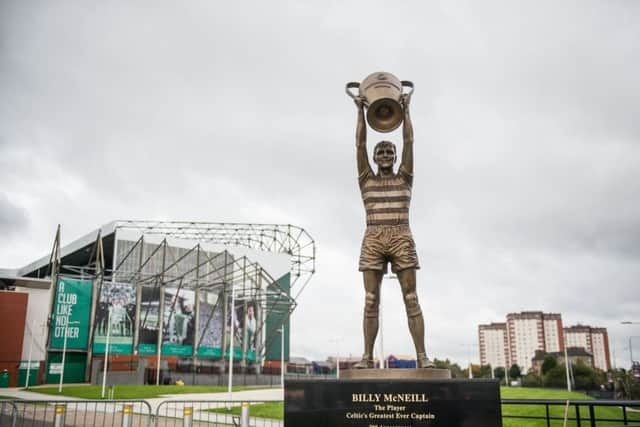Aidan Smith: I’ll never forget the first time I saw Billy McNeill
It sticks in the memory because this was the game which turned me onto football. I didn’t know that Willie was actually Billy, that the mag’s Scottish edition - ha ha - had got his name wrong. I also didn’t know what was meant by skipper and for a brief moment wondered if McNeill’s role was to lead the team, all equipped with skipping ropes, possibly with tassles on the handles like those belonging to my sisters, in choreographed routines.
But everyone knew about Celtic and Billy after the game. The club’s reputation spread far beyond the fabled ten-mile radius from where they’d drawn all but one of their players. And that man McNeill became the new all-comers weightlifting champion in the snatch division, lifting the great muckle trophy high above his fair head.


Advertisement
Hide AdAdvertisement
Hide AdReally, who in the Inter team could have done this? Yes, the Italian champions had the coiffeured hair, the musky colognes, the shirts made of breathable fabric and, most likely, all their own teeth - but they didn’t have a colossus like big Billy. His cup-hoisting pose - immortalised in bronze on the walk-up to Celtic Park - is the most famous in Scottish football, a celebration of our game’s single greatest achievement. It was then. It remains so now. It probably won’t be topped, ever.
When you’re ten years old and suddenly in thrall to football all players can look like giants out on the park but McNeill was Gigantor, a flesh-and-blood version of the 50ft robot from the popular kids’ cartoon of my youth.
How many times did opponents of that all-conquering Celtic side propel the ball hopefully skywards and how many times did McNeill rise imperiously from his centre-half berth and head it back at them with the force of a shot, or out to the wings where Jimmy Johnstone and Bobby Lennox were stationed, ready to spark another electric attack? By the law of averages and the likelihood of human fallibility even when you’re nicknamed Caesar, there must have been the odd occasion when he mistimed his jump but right now very few of us can ever remember this happening.
Something else which won’t be forgotten is the first time I saw McNeill in the flesh. This was a year after Lisbon at Hibernian’s Easter Road with the captain - the skipper - leading his men onto the park. The hoops on the shirts did wonders for the physique of those not quite as statuesque as their leader. They all looked like they’d been on a Charles Atlas correspondence course though McNeill had no real need of a chest-expander.
Hibs in contrast seemed completely puny and the crowd waited for them to have sand kicked in their faces from first whistle to last. But incredibly with just 11 minutes remaining they led 2-1. Enter McNeill. A crashing header - velocity of a volley - began the comeback. He strode back into position, clapping his hands twice. This was a signal: “On you go, lads.” On Celtic went. Three more goals followed in the next four minutes, 5-2 the final score. Victories over Rangers in the Jock Stein era will have been greeted with wilder acclaim by the Celtic masses but the discerning fan may have selected this one as the most vivid expression of their awesome power.
In The Scotsman, John Rafferty wrote of McNeill’s goal: “It was as if a wee boy had been holding the floodgates and he was swept aside and the torrent poured through.” Such a performance, he confirmed, was why Celtic were being talked about “in the football capitals of the world … in the way we used to rapturise about Real Madrid … a team who must be the fittest and the fastest to have ever trod turf.”
McNeill was never fast but then he didn’t have to be. He simply had to amble into the Rangers box for a corner, as he did in the third minute of the 1969 Scottish Cup final, plant another unsavable header into the opposition net and this - for the crime of not marking him - would ruin Alex Ferguson’s Ibrox career.
A few weeks later I was at Hampden - my first Scotland match - to see him score what would be his last goal in the dark blue of his 29-cap service to his country. Once again the great man showed the way and we ended up routing Cyprus 8-0. A few days after the 50th anniversary of that match, the current team will face the Cypriots in a vital Euros qualifier. Oh, to have the surety of a goal from big Billy that night.
Advertisement
Hide AdAdvertisement
Hide AdBy the time of the 1972 Scottish Cup final people were saying McNeill was finished. Well, hopeful Hibs fans were saying this, based on none-too-scientific evidence of him staying completely still during games, as if modelling for the sculpture which would one day celebrate his great deeds. What happened? He ambled upfield and when the ball reached him the inevitable happened again. This was in the second minute of the match. He was actually getting quicker.
